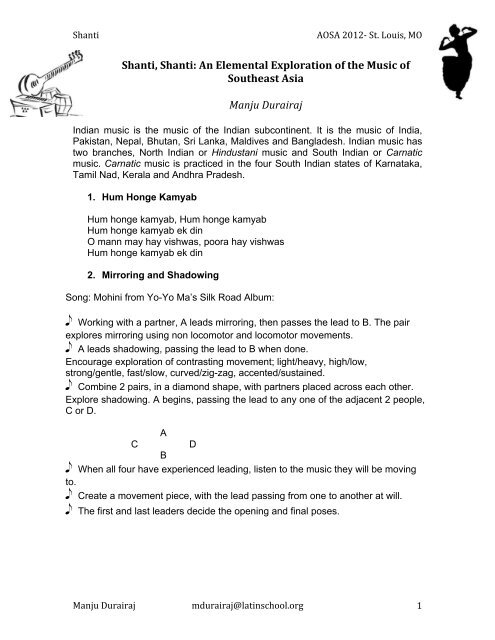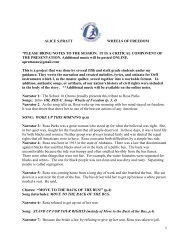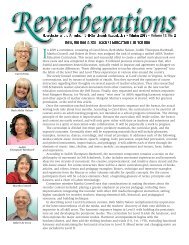Shanti, Shanti: An Elemental Exploration of the Music of Southeast ...
Shanti, Shanti: An Elemental Exploration of the Music of Southeast ...
Shanti, Shanti: An Elemental Exploration of the Music of Southeast ...
You also want an ePaper? Increase the reach of your titles
YUMPU automatically turns print PDFs into web optimized ePapers that Google loves.
<strong>Shanti</strong> <br />
AOSA 2012-‐ St. Louis, MO <br />
<strong>Shanti</strong>, <strong>Shanti</strong>: <strong>An</strong> <strong>Elemental</strong> <strong>Exploration</strong> <strong>of</strong> <strong>the</strong> <strong>Music</strong> <strong>of</strong> <br />
Sou<strong>the</strong>ast Asia <br />
Manju Durairaj <br />
Indian music is <strong>the</strong> music <strong>of</strong> <strong>the</strong> Indian subcontinent. It is <strong>the</strong> music <strong>of</strong> India,<br />
Pakistan, Nepal, Bhutan, Sri Lanka, Maldives and Bangladesh. Indian music has<br />
two branches, North Indian or Hindustani music and South Indian or Carnatic<br />
music. Carnatic music is practiced in <strong>the</strong> four South Indian states <strong>of</strong> Karnataka,<br />
Tamil Nad, Kerala and <strong>An</strong>dhra Pradesh.<br />
1. Hum Honge Kamyab<br />
Hum honge kamyab, Hum honge kamyab<br />
Hum honge kamyab ek din<br />
O mann may hay vishwas, poora hay vishwas<br />
Hum honge kamyab ek din<br />
2. Mirroring and Shadowing<br />
Song: Mohini from Yo-Yo Ma’s Silk Road Album:<br />
e Working with a partner, A leads mirroring, <strong>the</strong>n passes <strong>the</strong> lead to B. The pair<br />
explores mirroring using non locomotor and locomotor movements.<br />
e A leads shadowing, passing <strong>the</strong> lead to B when done.<br />
Encourage exploration <strong>of</strong> contrasting movement; light/heavy, high/low,<br />
strong/gentle, fast/slow, curved/zig-zag, accented/sustained.<br />
e Combine 2 pairs, in a diamond shape, with partners placed across each o<strong>the</strong>r.<br />
Explore shadowing. A begins, passing <strong>the</strong> lead to any one <strong>of</strong> <strong>the</strong> adjacent 2 people,<br />
C or D.<br />
A<br />
C<br />
D<br />
B<br />
e When all four have experienced leading, listen to <strong>the</strong> music <strong>the</strong>y will be moving<br />
to.<br />
e Create a movement piece, with <strong>the</strong> lead passing from one to ano<strong>the</strong>r at will.<br />
e The first and last leaders decide <strong>the</strong> opening and final poses.<br />
Manju Durairaj mdurairaj@latinschool.org 1
<strong>Shanti</strong> <br />
AOSA 2012-‐ St. Louis, MO <br />
3. Peace Canon<br />
e Echo sing <strong>the</strong> song by phrases, combining phrases until <strong>the</strong> melody and lyrics<br />
are secure.<br />
e Add <strong>the</strong> hand drum.<br />
e Once melody is secure, divide into groups <strong>of</strong> four and create movement using<br />
‘shadowing’<br />
e First sing in unison <strong>the</strong>n three more times in canon.<br />
e The group that finishes first freezes or melts in place.<br />
e Teach melodic ostinato using sargam.<br />
(<strong>An</strong> ostinato is a repeated melodic or rhythmic pattern. 2 or more ostinati may be<br />
layered to create an accompaniment. When ostinati are added, <strong>the</strong>y should<br />
complement <strong>the</strong> main melody, preferably by providing a rhythmic contrast)<br />
Indian music uses sargam, a system similar to solfegge. The degrees <strong>of</strong> <strong>the</strong> scale<br />
are Sa, re, ga, ma, pa, dha, ni, sa. The tonal centre is always sa, irrespective <strong>of</strong><br />
<strong>the</strong> melody being ‘do’ or ‘la’ based.<br />
e Transfer melodic ostinato to bass xylophones.<br />
e Use pat-clap to teach alto xylophone part and transfer to instruments.<br />
e Use snap to teach soprano xylophone part. The timing is tricky and players<br />
need to listen to <strong>the</strong> BX part to be accurate.<br />
e Solicit and explore ideas for instrumental introduction and coda.<br />
e Perform <strong>the</strong> piece including created movement.<br />
4. Speech Piece using Bol<br />
The concept <strong>of</strong> meter is precisely defined in Indian music. Each Tala or <strong>the</strong> ‘meter<br />
system’ <strong>of</strong> a piece may be compared but is not identical to a rhythmic ostinato. It is<br />
a beat cycle that consists <strong>of</strong> a specific number <strong>of</strong> measures with a specific number<br />
<strong>of</strong> beats. The part that may confuse western music practitioners is that all<br />
measures in <strong>the</strong> cycle may not necessarily contain an equal number <strong>of</strong> beats.<br />
Indian percussionists use an extensive vocabulary. Every stroke, and every<br />
combination <strong>of</strong> strokes played on <strong>the</strong>ir instruments, has a specific name. Each <strong>of</strong><br />
<strong>the</strong>se is assigned a specific syllable. These are called ‘bol’. However, since<br />
dancers and singers also use bol extensively, <strong>the</strong>re may be a nebulous consensus<br />
on <strong>the</strong> terminology.<br />
Manju Durairaj mdurairaj@latinschool.org 2
<strong>Shanti</strong> <br />
AOSA 2012-‐ St. Louis, MO <br />
Dha dha dhin dha, ta-ki-ta ta-ka dhin ((wave)<br />
Ta-ka ta dhin dha, (wave) ta-ka dhin (wave)<br />
Key: <br />
5. Speech Piece <br />
e Speak <strong>the</strong> rhythm <strong>of</strong> <strong>the</strong> above A section using Kodaly rhythm syllables<br />
e Introduce Indian rhythmic syllables<br />
e Using <strong>the</strong> 2 beat rhythm cards provides groups create <strong>the</strong>ir own 16 beat<br />
sections<br />
e Create body percussion to accompany <strong>the</strong> created sections<br />
e Perform as a rondo<br />
e Participants have created a speech piece in Teental, a beat cycle <strong>of</strong> 4 measures<br />
with 4 beats in each measure.<br />
6. Recorder Piece -‐ Kafi Raga (dorian mode) <br />
Manju Durairaj mdurairaj@latinschool.org 3
<strong>Shanti</strong> <br />
AOSA 2012-‐ St. Louis, MO <br />
<strong>Shanti</strong><br />
Peace within my heart<br />
Peace within my mind<br />
There is peace in every nation<br />
There is peace in every land<br />
Dil main shanti hay<br />
Mann main shanti hay<br />
<strong>Shanti</strong> shanty shant hay duniya<br />
Jugg main shanti hay<br />
La paix est dans mon coeur<br />
La paix est dans mon âme<br />
La paix dans tous les pays<br />
La paix pour tout le monde<br />
Paz en mi corazon<br />
Paz en mi alma<br />
En todos países hay paz<br />
En todo el mundo hay paz<br />
Peace within my heart<br />
Peace within my mind<br />
There is peace in every nation<br />
There is peace in every land<br />
Diwali<br />
Diwali, diwali, Diwali, diwali, Diwali, diwali,<br />
Hey o hey….(2)<br />
Nacho, gao, diya jalao<br />
Nacho, gao, mawj manao, hey o hey<br />
refrain<br />
Dance and sing and light <strong>the</strong> lamps<br />
Dance and sing and let’s have fun, Hey o<br />
hey……(2)<br />
refrain<br />
Hey o hey, Hey o hey Hey!<br />
Ramadan<br />
The ninth month <strong>of</strong> <strong>the</strong> lunar year<br />
The month called Ramadan<br />
Moslem children far and near<br />
Celebrate Ramadan<br />
Salam Ailekum, Ramzan Mubarak!<br />
From dawn to dusk each day<br />
Of <strong>the</strong> month <strong>of</strong> Ramadan<br />
Moslem children fast and pray<br />
To celebrate Ramadan<br />
Salam Ailekum, Ramzan Mubarak!<br />
It’s a wonderful happy day<br />
At <strong>the</strong> end <strong>of</strong> Ramadan<br />
Moslem children smile and say<br />
Salam Ailekum, Eid Mubarak!<br />
The End!<br />
Manju Durairaj mdurairaj@latinschool.org 4






